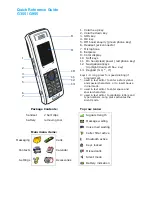
VX8700
105
are going. It is common sense. Do not get
caught in a dangerous situation because you are
reading or writing and not paying attention to the
road or nearby vehicles.
6. Dial sensibly and assess the traffic; if possible,
place calls when you are not moving or before
pulling into traffic. Try to plan your calls before
you begin your trip or attempt to coincide your
calls with times you may be stopped at a stop
sign, red light, or otherwise stationary. But if you
need to dial while driving, follow this simple tip --
dial only a few numbers, check the road and
your mirrors, then continue.
7. Do not engage in stressful or emotional
conversations that may be distracting. Stressful
or emotional conversations and driving do not
mix; they are distracting and even dangerous
when you are behind the wheel of a car. Make
people you are talking with aware you are
driving and if necessary, suspend conversations
which have the potential to divert your attention
from the road.
8. Use your wireless phone to call for help. Your
wireless phone is one of the greatest tools you
can own to protect yourself and your family in
dangerous situations -- with your phone at your
side, help is only three numbers away. Dial 911
or other local emergency number in the case of
fire, traffic accident, road hazard, or medical
emergency. Remember, it’s a free call on your
wireless phone!
9. Use your wireless phone to help others in
emergencies. Your wireless phone provides you
a perfect opportunity to be a “Good Samaritan”
in your community. If you see an auto accident,
crime in progress or other serious emergency
where lives are in danger, call 911 or other local
emergency number, as you would want others to
do for you.
10. Call roadside assistance or a special wireless
non-emergency assistance number when
necessary. Certain situations you encounter
while driving may require attention, but are not
urgent enough to merit a call for emergency












































